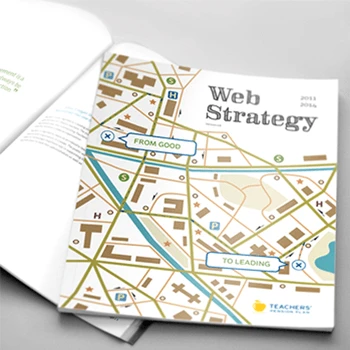What exactly are web personas and why do we need them?
Web personas are research-based character profiles that represent distinct groups of people who share common goals and needs when using your website or portal. Rather than designing for everyone, personas help you focus on specific users with names, personalities, backgrounds, and usage goals. They keep real users front-and-center during planning, design, and development of websites and portals.
Tip: Start by examining whether your current decisions are based on actual user research or internal assumptions about who your users are.
How do personas differ from market segments or demographics?
Personas are defined by common usage goals rather than demographic characteristics. While market segments group people by age, income, or location, personas unite people who have similar needs and motivations when using your website. A persona might include users from widely different demographic groups who share the same goals and task priorities.
Tip: Focus on what users are trying to accomplish rather than who they are demographically to create more actionable persona insights.
What types of personas do you create for web projects?
We create user personas, customer personas, and service personas depending on your web portal's purpose. Through our Experience Thinking framework, we examine how different audiences experience your brand, content, product, and service through web interactions. This includes understanding the customer-to-user-to-client lifecycle and how personas evolve through these stages.
Tip: Consider creating different persona types that represent various stages of your user lifecycle rather than just focusing on current active users.
How many personas should we have for our web project?
Typically, we develop between 2-8 personas per web project based on distinct usage goals and needs patterns. The number depends on your audience diversity and website complexity. Too few personas miss important user groups, while too many become unmanageable for design decisions. We prioritize personas based on business importance, frequency of use, or criticality of their success.
Tip: Start with primary personas representing your most important user groups, then add secondary personas only if they have significantly different usage goals.
What makes personas effective for website planning and design?
Effective personas remind design creators that they themselves are not the target audience and provide concrete reference points for design decisions. Each persona includes specific characteristics like domain experience, system frequency of use, key motivations, and environmental context that directly inform interface design, content organization, and functionality priorities.
Tip: Use personas actively in design meetings by asking 'How would [persona name] approach this task?' rather than treating personas as static documentation.
How do personas connect to our overall user experience strategy?
Personas form the foundation for journey mapping, content strategy, and information architecture decisions. Through our Experience Thinking approach, personas help connect brand expression, content organization, product functionality, and service delivery into cohesive user experiences. They ensure all strategic decisions consider actual user needs rather than internal organizational structure.
Tip: Integrate persona insights into your content governance and design system decisions to maintain user-centered consistency across all touchpoints.
What research methods do you use to create web personas?
We combine internal stakeholder interviews and workshops with external user research including contextual inquiry, ethnographic research, and user interviews. Internal research captures existing organizational knowledge while external research validates assumptions and reveals actual user behaviors, motivations, and environmental contexts that affect web usage.
Tip: Start with internal stakeholder research to identify what you think you know about users, then validate these assumptions through direct user research.
How do you research users who are hard to reach?
For hard-to-reach users, we work with organizations to identify client-facing staff, support personnel, and customer service representatives who have direct user contact. We also use online surveys, remote interviews, and partner organizations to access specific user groups. The research approach adapts to user availability and organizational constraints.
Tip: Leverage your existing customer service and support data to identify user patterns and pain points even when direct user access is limited.
What's your approach to B2B persona research?
B2B persona research examines both individual user needs and organizational context including approval processes, collaborative workflows, and role relationships. We research how personas function within their work environment, what organizational constraints they face, and how decisions get made in their context. This includes understanding different personas within the same organization.
Tip: Include multiple organizational levels in B2B research to understand both end-user needs and decision-maker priorities that affect web portal adoption.
How do you validate persona accuracy after creation?
We validate personas through additional user interviews, usability testing with real users, and analytics analysis that confirms persona behaviors match actual usage patterns. Validation includes testing persona-based design decisions with users to ensure personas predict actual user responses and preferences accurately.
Tip: Plan validation activities during persona development rather than waiting until implementation to discover whether personas accurately represent real users.
What role does competitive analysis play in persona research?
Competitive analysis reveals how similar organizations serve comparable user groups and identify unmet needs in the market. We examine competitor user experiences to understand industry standards, identify differentiation opportunities, and validate persona needs across the competitive landscape. This helps position your web portal strategically.
Tip: Focus competitive analysis on user experience quality and task support rather than just feature comparison to identify real opportunities for persona-driven differentiation.
How do you research emerging user behaviors and expectations?
We use foresight design methods to explore changing user expectations, technology adoption patterns, and cultural shifts that might impact persona needs. This includes interviewing early adopters, analyzing trend data, and examining how current user behaviors might evolve over time. Future-oriented persona research helps create resilient designs.
Tip: Include users who are technology leaders and early adopters in your research to understand emerging behavior patterns that might affect persona needs.
How does artificial intelligence impact persona research methods?
AI enhances persona research by analyzing large datasets to identify user behavior patterns, synthesizing qualitative research findings, and generating hypotheses for human validation. We use AI to process user feedback at scale and identify persona segments, while maintaining human oversight for strategic interpretation and empathy-based insights that AI cannot provide.
Tip: Use AI for pattern identification and initial data analysis but always validate AI insights through direct user interaction and human interpretation.
How do personas connect to the customer experience lifecycle?
Through our Experience Thinking framework, we map personas across the customer-to-user-to-client lifecycle. Customer personas focus on evaluation and purchase decisions, user personas emphasize task completion and interaction needs, while client personas represent long-term advocacy and relationship maintenance. This lifecycle view ensures comprehensive experience planning.
Tip: Map how persona motivations and goals change as they move through the lifecycle rather than treating personas as static throughout the entire relationship.
What's your approach to connecting personas with journey mapping?
Personas provide the foundation for journey mapping by defining who is experiencing the journey and what their specific goals are at each stage. We create detailed journey maps for each primary persona, showing their activities, emotions, pain points, and opportunities throughout their experience with your web portal and related touchpoints.
Tip: Create journey maps for your primary personas first, then identify common pain points and opportunities that affect multiple persona types.
How do personas influence content strategy and information architecture?
Personas directly inform content organization by revealing user mental models, task priorities, and language preferences. We use persona insights to structure information according to user thinking patterns rather than internal organizational structure. This includes understanding how different personas search for and process information differently.
Tip: Use persona language and terminology preferences to guide content creation and navigation labeling rather than defaulting to internal organizational terminology.
What role do personas play in brand experience through web interactions?
Personas help translate brand strategy into specific interaction patterns that resonate with user expectations and preferences. Through our Experience Thinking approach, we examine how brand personality traits should be expressed through persona-specific interactions, content tone, and interface behaviors that create authentic brand connections.
Tip: Define how your brand personality should be expressed differently for different personas while maintaining overall brand consistency.
How do you integrate personas with service design for web portals?
Personas inform service blueprints by revealing user needs that require human support, self-service capabilities, and hybrid assistance models. We examine how personas move between web self-service and human assistance, what triggers these transitions, and how to design seamless service experiences that serve persona-specific preferences.
Tip: Map persona preferences for self-service versus human assistance to design appropriate service options and transition points throughout their journey.
How do personas guide responsive and mobile web strategy?
Personas reveal context-specific needs including device preferences, environmental constraints, and task priorities that vary across usage situations. We examine how persona goals change in mobile contexts and design responsive strategies that prioritize the most important persona tasks for each device and context combination.
Tip: Research persona context variations across devices rather than assuming the same persona has identical needs on all platforms.
How do you help stakeholders embrace persona-driven design?
We facilitate stakeholder workshops that connect internal teams with persona research findings through empathy-building exercises and design decision simulations. Stakeholders experience personas through role-playing scenarios that demonstrate how persona-driven decisions improve user success and business outcomes. This builds organizational commitment to user-centered thinking.
Tip: Create shared stakeholder experiences with persona research rather than just presenting reports to build genuine empathy and commitment to persona-driven decisions.
What governance structures support persona-driven web development?
Persona governance includes decision-making frameworks that reference persona needs, design review processes that validate persona alignment, and update cycles that keep personas current with changing user needs. We establish persona ownership, maintenance responsibilities, and integration points within existing development workflows.
Tip: Assign specific team members to advocate for each primary persona during design decisions rather than treating personas as shared but unowned resources.
How do you handle conflicting persona needs in design decisions?
When persona needs conflict, we facilitate prioritization discussions based on business strategy, persona importance, and task criticality. We explore design solutions that serve multiple personas effectively and help stakeholders understand trade-offs. Sometimes this leads to persona-specific experiences or progressive disclosure approaches.
Tip: Establish clear persona prioritization criteria during research rather than trying to resolve conflicts during design when timeline pressure is higher.
What internal capabilities do organizations need for ongoing persona management?
Ongoing persona success requires user research capabilities, analytics interpretation skills, and design decision frameworks that reference persona insights. We help organizations develop internal expertise in persona validation, update processes, and integration with design systems. This includes training stakeholders in persona-based decision making.
Tip: Build internal capabilities for persona research and validation rather than depending entirely on external support for persona maintenance and evolution.
How do you measure the impact of persona-driven design decisions?
We measure persona impact through task completion rates, user satisfaction improvements, and behavioral changes that indicate better persona alignment. Measurement includes both quantitative metrics like conversion rates and qualitative feedback that confirms personas accurately represent user needs and motivations.
Tip: Establish baseline measurements before implementing persona-driven changes to demonstrate the business value of persona research investment.
What training do internal teams need to use personas effectively?
Effective persona utilization requires training in user empathy, design decision frameworks, and research interpretation skills. We provide workshops on persona-based decision making, journey mapping techniques, and integration with design processes. Training helps teams move beyond persona documentation to active persona application.
Tip: Focus training on practical persona application in real design scenarios rather than just explaining persona theory and research methods.
How do personas inform information architecture and navigation design?
Personas reveal user mental models and task flows that inform content organization and navigation structure. We use persona insights to design navigation paths that match user thinking patterns, priority content placement that serves persona goals, and search functionality that supports persona-specific information seeking behaviors.
Tip: Test information architecture concepts with real users from your persona groups rather than just validating with internal stakeholders.
What's your approach to persona-driven interface design?
Interface design decisions reference persona capabilities, preferences, and environmental constraints including technical skill levels, device usage patterns, and accessibility needs. We translate persona insights into specific design patterns, interaction methods, and visual hierarchy decisions that support persona success in their actual usage contexts.
Tip: Create design patterns that accommodate your least experienced persona while remaining efficient for your most experienced users.
How do you integrate personas with usability testing?
We recruit testing participants who match persona characteristics and test scenarios that reflect persona goals and contexts. Testing validates whether persona-driven design decisions actually improve user success and reveals gaps between persona assumptions and real user behavior. This iterative approach refines both personas and designs.
Tip: Test with users from different persona groups separately to understand how design decisions affect each persona type differently.
How do personas influence content creation and messaging strategy?
Personas guide content tone, language complexity, information depth, and presentation format based on user preferences and expertise levels. We develop content guidelines that serve persona-specific needs while maintaining brand consistency. This includes understanding how different personas consume and process information.
Tip: Create content templates and guidelines that specify how to adapt messaging for different persona types while maintaining overall brand voice.
What's your approach to persona-driven performance optimization?
Performance optimization considers persona context including device capabilities, network conditions, and task urgency. We prioritize performance improvements that affect persona critical paths and design progressive loading strategies that serve persona needs effectively across different technical contexts.
Tip: Prioritize performance optimization for persona task flows that are business-critical rather than optimizing all features equally.
How do you implement foresight design considerations into persona-driven development?
Foresight design helps anticipate how persona needs might evolve with changing technology, user expectations, and cultural shifts. We build flexibility into persona-driven designs that can adapt to emerging user behaviors while maintaining current persona effectiveness. This includes considering how personas might change over time.
Tip: Design persona-driven solutions with modular architecture that can evolve as user needs and technology capabilities change.
How do you ensure persona research represents actual users rather than assumptions?
All personas link to primary user research data including contextual inquiry, ethnographic observation, and direct user interviews. We validate internal stakeholder knowledge against external user research findings and identify gaps between organizational assumptions and actual user behavior. Research-based personas include specific data sources and confidence levels.
Tip: Document the research evidence behind each persona characteristic to enable validation and updates based on new user data.
What's your process for updating personas as user needs evolve?
Persona updates involve ongoing user research, analytics monitoring, and feedback collection that reveals changing user needs and behaviors. We establish update cycles based on market changes, technology adoption, and business evolution. Updates maintain persona relevance while preserving design investment in persona-driven solutions.
Tip: Plan regular persona review cycles based on your industry change rate rather than waiting for obvious signs that personas are outdated.
How do you validate persona accuracy across different user segments?
Validation includes testing persona assumptions with users from different geographic regions, organizational types, and experience levels to ensure personas accurately represent intended user groups. We examine whether persona characteristics hold true across the full range of users they're meant to represent.
Tip: Test persona accuracy with edge cases and boundary users to ensure personas remain valid across your complete user spectrum.
What methods do you use to identify missing or overlooked personas?
We use analytics analysis, customer service data, and broader user research to identify user groups that might not be captured in initial persona research. This includes examining user behavior patterns that don't match existing personas and investigating whether new user segments are emerging in your audience.
Tip: Monitor analytics for user behavior patterns that don't match any current persona as indicators of missing user groups or evolving persona needs.
How do you measure whether personas actually improve design outcomes?
We measure persona effectiveness through improved task completion rates, reduced user support needs, and increased user satisfaction scores for persona-driven design changes. Measurement includes comparing pre- and post-persona implementation metrics to demonstrate the value of persona-driven decision making.
Tip: Establish measurement frameworks that connect persona-driven design decisions to business outcomes rather than just measuring persona usage within your organization.
What quality indicators show that persona research is thorough and actionable?
Quality personas include specific behavioral details, environmental context, task priorities, and emotional motivations based on direct user research. They enable specific design decisions and predict user responses to interface changes. Quality indicators include research source documentation, validation data, and demonstrated design application success.
Tip: Evaluate persona quality by testing whether they enable specific design decisions and predict actual user responses rather than just providing general user descriptions.
How do persona research insights influence broader business strategy?
Persona insights reveal market opportunities, competitive positioning potential, and user needs that inform product development and service strategy beyond just web design. Through our Experience Thinking framework, personas connect brand strategy, content strategy, product development, and service delivery into unified customer-centered business approaches.
Tip: Share persona insights with business strategy stakeholders to identify opportunities beyond web portal improvements that could create competitive advantage.
What long-term value does persona research provide to organizations?
Long-term persona value includes improved user satisfaction, reduced development costs through better design decisions, increased conversion rates, and stronger customer relationships. Personas build organizational user empathy and decision-making capabilities that improve all customer-facing initiatives, not just web projects.
Tip: Track persona impact across multiple projects and initiatives to demonstrate cumulative organizational value rather than just measuring individual project success.
How do personas help identify new market opportunities?
Persona research reveals unmet user needs, underserved market segments, and emerging user behaviors that suggest new product or service opportunities. We examine persona pain points and goals that current solutions don't address effectively, identifying innovation opportunities that leverage deep user understanding.
Tip: Analyze persona pain points and unmet needs as innovation opportunities rather than just focusing on improving current web portal functionality.
What role do personas play in organizational digital transformation?
Personas provide user-centered foundation for digital transformation by ensuring technology investments serve actual user needs rather than just organizational efficiency goals. They guide platform decisions, integration priorities, and change management approaches that maintain user experience quality throughout transformation.
Tip: Use personas to evaluate digital transformation decisions based on user impact and adoption likelihood rather than just technical capabilities or cost considerations.
How do personas support competitive differentiation in the market?
Deep persona understanding reveals user needs that competitors aren't serving effectively, enabling differentiated positioning and user experience advantages. Personas help identify where superior user understanding can create sustainable competitive advantages through better problem-solving and user satisfaction.
Tip: Focus persona-driven differentiation on solving user problems that competitors haven't recognized or addressed rather than just adding features.
What future trends should we consider when developing personas for web projects?
Current trends include increasing expectations for personalization, voice and conversational interfaces, cross-device continuity, and privacy-conscious experiences. Through foresight design approaches, we help organizations prepare personas for emerging interaction patterns while maintaining relevance for current user needs and technological capabilities.
Tip: Build persona research and design flexibility that can adapt to emerging user behaviors and technology capabilities rather than optimizing only for current usage patterns.












